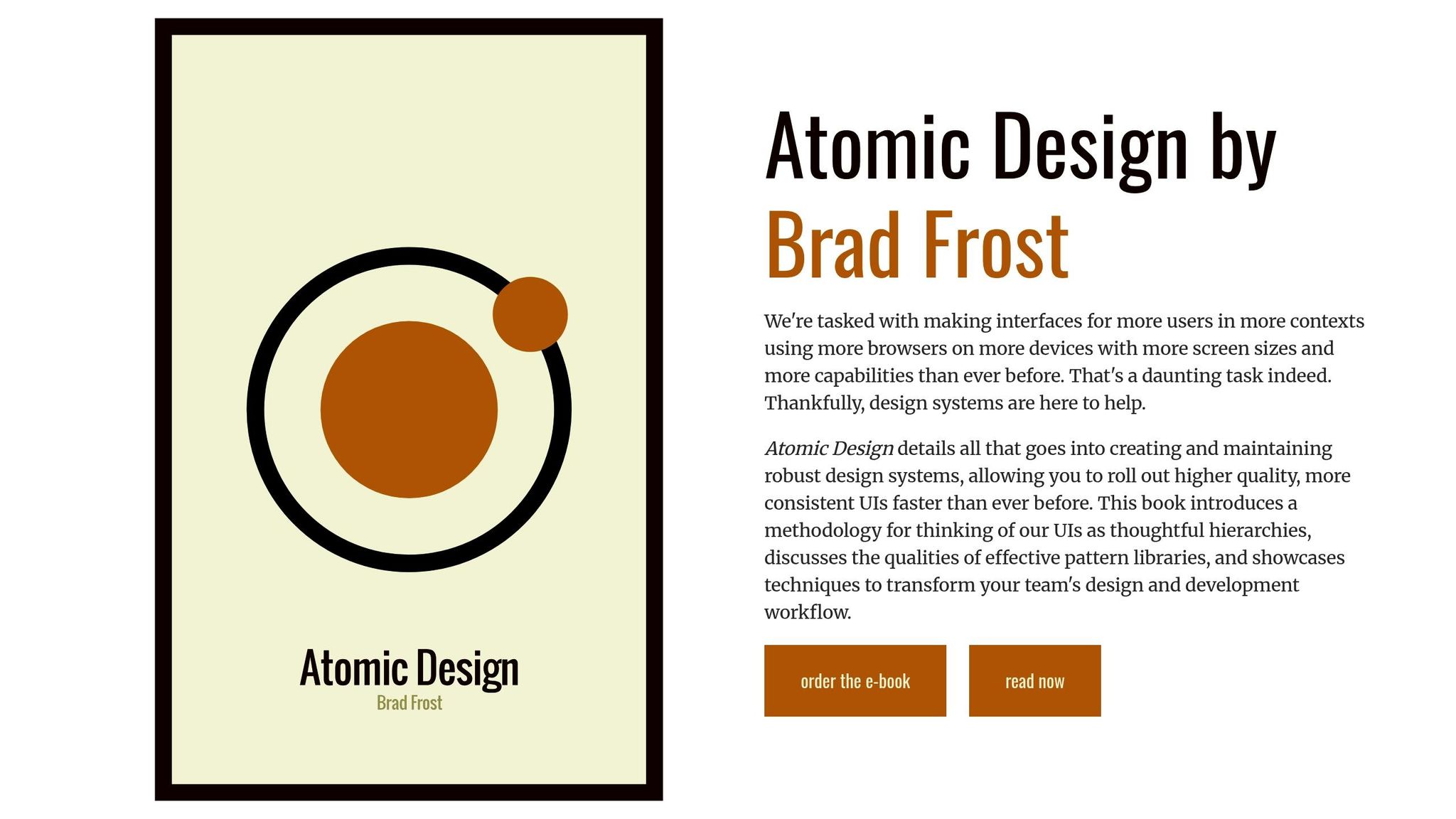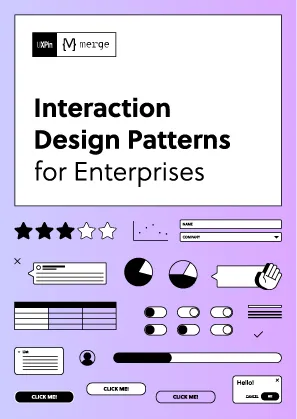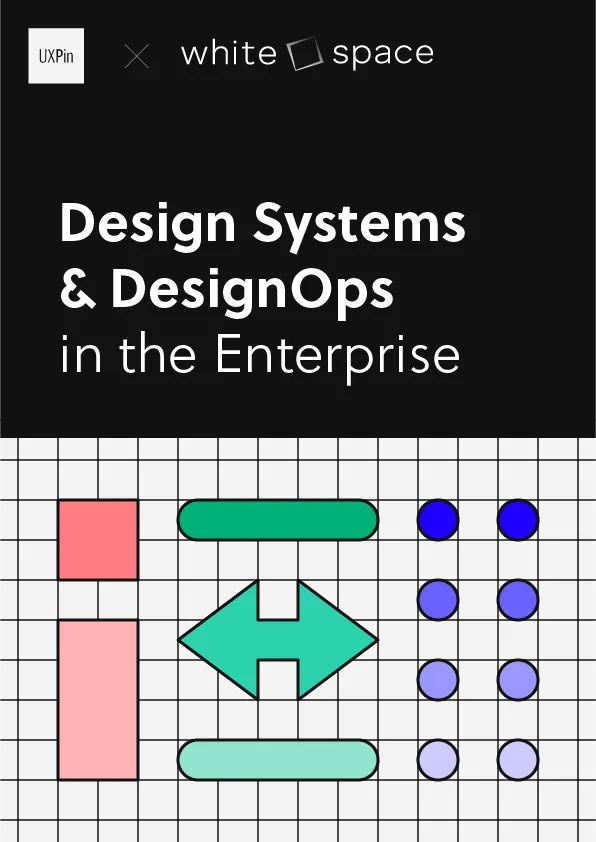A scalable design pattern library ensures consistent and efficient UI/UX design across projects. It streamlines collaboration, saves time, and reduces development costs. Here’s how to build one:
- Set Clear Goals: Define objectives like reducing inconsistencies, improving collaboration, and meeting accessibility standards.
- Audit Existing Components: Identify duplicates, updates needed, and usage frequency.
- Choose the Right Tools: Opt for platforms with component libraries, version control, and real-time collaboration.
- Organize with Atomic Design: Break components into Atoms, Molecules, Organisms, Templates, and Pages.
- Standardize Naming: Use clear, consistent names for components and document the rules.
- Focus on Accessibility: Ensure WCAG compliance and responsive design.
- Document Everything: Include usage guidelines, code examples, and accessibility notes.
- Regularly Update: Schedule reviews, track changes, and gather user feedback to keep the library relevant.
Key Benefits: Teams using code-backed components report up to 50% faster development times. Start small with essential elements like typography and buttons, and expand as needed, ensuring alignment between design and development teams.
Building Your Own Pattern Library for the Web: Introduction
1. Initial Setup
Building a design library that works well starts with thoughtful planning.
Set Goals and Boundaries
Start by defining what you want to achieve with your pattern library. Some common objectives include:
- Cutting down on design inconsistencies
- Simplifying the design-to-development process
- Boosting team collaboration
- Meeting accessibility standards
- Keeping branding consistent
For example, one design team shared that their productivity jumped after implementing a custom React Design System.
Once your goals are in place, take a methodical approach to review your current design assets.
Review Current Design Elements
Conduct a thorough audit of your existing UI components. Here’s how:
- List all your current UI components
- Spot duplicates or inconsistencies
- Identify components that need updates
- Map out how components relate to each other
- Tag components based on how often they’re used
Choose Your Tools
The tools you choose should align with your library’s goals and technical needs. Look for platforms that include:
- Component libraries tied to code
- Version control features
- Developer handoff tools
- Real-time collaboration options
- Built-in documentation capabilities
The right tools can save a lot of time for your engineering team.
Once you’ve picked your tools, set clear rules to keep the library organized and up to date.
Set Management Rules
| Aspect | Guidelines |
|---|---|
| Access Control | Define who can view, edit, and approve changes |
| Update Process | Outline steps for updating or adding components |
| Documentation | Set standards for documenting components |
| Version Control | Decide how versions will be tracked and managed |
| Quality Checks | Establish criteria that components must meet before approval |
2. Library Structure
An organized design pattern library makes it easier to find and use components. A clear structure ensures designers and developers can work efficiently while maintaining consistency across projects.
Use Atomic Design

Atomic Design breaks components into five levels:
| Level | Description | Examples |
|---|---|---|
| Atoms | Basic elements | Buttons, inputs, labels |
| Molecules | Small component groups | Search forms, navigation items |
| Organisms | Larger UI sections | Headers, product cards |
| Templates | Page layouts | Article layouts, dashboard grids |
| Pages | Specific instances | Home page, product detail view |
Using code-backed components ensures uniformity. A clear hierarchy combined with consistent naming conventions makes components easier to discover and use.
Set Naming Rules
- Follow consistent patterns
Start with the component type, then add its variant and state:
button-primary-disabled card-featured-hover input-search-focus - Keep names clear
Use descriptive and readable names. For example, write ‘navigationMenuHorizontal’ instead of ‘navMenuH’.
- Document the rules
Include details like:
- Approved prefixes and suffixes
- Capitalization guidelines
- Version numbering
- Indicators for states and variants
When components are properly named and organized, they should also be built with accessibility and responsiveness in mind.
Focus on Accessibility and Responsiveness
Every component should meet accessibility and responsiveness standards:
- Follow WCAG 2.1 guidelines
- Include responsive breakpoints
- Support keyboard navigation
- Ensure proper color contrast
Component documentation should cover:
- Behavior at different breakpoints
- Accessibility standards and testing notes
- Implementation instructions
- Code examples
- Known limitations or edge cases
sbb-itb-f6354c6
3. Component Creation
Develop reusable, code-supported components with thoughtful planning and clear documentation to maintain consistent design and functionality.
Build Reusable Elements
Components should be designed to work across various scenarios while staying consistent. Each one needs well-defined states, variants, and configurable properties that both designers and developers can work with seamlessly.
Here’s what to focus on when creating components:
- State Management: Define how your components respond in different scenarios, such as:
- Default
- Hover
- Active
- Disabled
- Error
- Loading
- Variant Support: Ensure components can adapt to various contexts while keeping their core purpose intact. Examples include:
- Sizes: small, medium, large
- Styles: outlined, filled, ghost
- Contexts: primary, secondary, danger
- Property Configuration: Standardize properties like colors, typography, spacing, and icon placement to maintain uniformity.
Provide Clear Documentation
Good documentation is essential for proper component usage and implementation. Here’s what to include:
| Section | Description | Example Content |
|---|---|---|
| Overview | Briefly describe the component | Primary button for main user actions |
| Usage Guidelines | Explain when and where to use it | Use for key CTAs; limit to one per section |
| Properties | List customization options | Size, color, icon position, label text |
| Code Examples | Offer sample implementations | React component with props and styling |
| Accessibility | Include compliance details | ARIA labels, keyboard navigation, contrast ratios |
Collaborate closely with your development team to ensure these guidelines translate into effective implementation.
Coordinate with Development
To keep design and development in sync, follow these steps:
- Version Control
- Track changes to components
- Document updates thoroughly
- Ensure backward compatibility
- Communicate any breaking changes
- Testing Protocols
- Conduct visual regression tests
- Test functionality thoroughly
- Check cross-browser compatibility
- Measure performance
- Implementation Guidelines
- Provide instructions for initializing components
- Specify required dependencies
- Address performance considerations
- Define supported browsers
4. Updates and Growth
Keep your design library up to date with regular reviews and a clear plan for growth.
Schedule Regular Reviews
Set up monthly audits to assess how your design library is being used, streamline components, and evaluate performance.
Focus on these key areas:
- Usage Analytics: Monitor which components are used most often and decide if any need updates or removal.
- Performance Checks: Build on initial testing by conducting regular performance evaluations.
- Documentation Status: Ensure all documentation reflects the latest component versions.
- Accessibility Compliance: Confirm components meet current WCAG standards as they evolve.
Track Changes
After each review, document all updates to maintain consistency and transparency. Use version control to keep everything organized.
| Version Control Element | Purpose | Implementation |
|---|---|---|
| Semantic Versioning | Track version updates | Use format v2.1.3 (major.minor.patch) |
| Changelog Documentation | Record changes | Include updates and breaking changes |
| Migration Guidelines | Assist with transitions | Provide clear upgrade instructions |
Proper version tracking ensures updates are communicated effectively and integrates user feedback smoothly.
Collect User Input
User feedback is essential for improving and expanding your design library. Combine this input with quality checks for the best results.
"What used to take days to gather feedback now takes hours. Add in the time we’ve saved from not emailing back-and-forth and manually redlining, and we’ve probably shaved months off timelines." – Mark Figueiredo, Sr. UX Team Lead at T.RowePrice
Here are some ways to gather feedback:
- Direct User Surveys: Run quarterly surveys to gather input on component usability, documentation clarity, feature suggestions, and integration issues.
- Usage Analytics: Analyze metrics like adoption rates, documentation views, search trends, and error reports to spot areas for improvement.
- Team Workshops: Host monthly cross-functional meetings to discuss feedback, prioritize updates, and address technical challenges.
5. Growth Guidelines
Growing your design pattern library takes planning and teamwork to ensure everything stays organized and efficient. Here’s how to expand while keeping things running smoothly.
Start with the Essentials
Focus on the basics before diving into more detailed patterns. Build a strong base with key elements like typography, color systems, layouts, and interactive components. This foundation might include:
- Text styles and headings
- A consistent color palette with primary, secondary, and semantic colors
- Layout elements such as grids and containers
- Interactive components like buttons and form fields
Once your core components are solid, you can introduce advanced patterns based on team feedback and how the library is being used.
Align Design and Development Teams
Once your core components are in place, make sure your design and development teams are working in sync. Create shared documentation that covers component specs, usage guidelines, code examples, and design principles. Schedule regular cross-team meetings, like bi-weekly syncs, to review new proposals, discuss any technical challenges, and ensure smooth implementation.
Keep Performance in Check
As your library grows, keep an eye on performance. Track metrics like load times and resource usage to spot issues early. Regular monitoring ensures your library stays fast and efficient, making it easier to integrate across projects without slowing anything down.
Conclusion
Building a design library that scales requires careful planning, consistent upkeep, and collaboration. Studies reveal that using code-backed components can improve productivity and reduce engineering time by as much as 50%. Here are some practical tips to make it work:
A well-organized pattern library bridges the gap between design and development. As Design Leader David Snodgrass puts it:
Been a fan. The deeper interactions, the removal of artboard clutter creates a better focus on interaction rather than single screen visual interaction, a real and true UX platform that also eliminates so many handoff headaches.
To keep your pattern library effective:
- Start with essential components like typography, colors, and basic UI elements.
- Conduct regular reviews to assess how components are performing and being used.
- Use metrics to measure the library’s impact.
- Encourage teamwork by sharing documentation and maintaining open communication.

